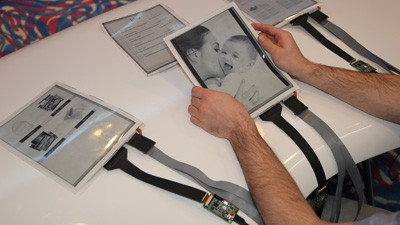
To the Human Media Laboratory (HML) at Queen's University in Canada, we're all living in the past. The lab's head, Dr Roel Vertegaal, regards modern smartphones as little more than old technology. "If you look at something like an iPhone, it's nothing but an improved version of what's been around since the mid-80s. There have been actual advances in terms of user controls, but it's amazing how little progress has been made."
Today's phones are more powerful and they have nifty touch-screens, but it isn't hard to see their common lineage with the bricks of the late 20th century.
Vertegaal isn't being dismissive - it's just old technology. The paradigm is even more stark when you consider the windows on our desktops, an innovation almost as old as the modern PC. "The only reason why computers have windows is because they have one small screen that needs to be divided up," he says. This became a challenge for HML. The labs have previously made breakthroughs such as faux-holographic tubes that bring body language to teleconferencing [Brainstorm, July 2012]. Crossing the boundaries that current technology defines is what drives the lab, pushing it to reinvent one of our oldest technologies.
"Paper shines as a display - it's fantastic. So we basically mimicked that element," says Vertegaal. The experiments started a decade ago. Vertegaal and his team toyed with projectors and paper, displaying data on a sheet, then manipulating it through how that sheet is moved.
Paper 2.0
At the Consumer Electronics Show (CES) this year, HML revealed a device that embraces this concept. Utilising screen technology from Plastic Logic, it debuted PaperTab. The real device is far from landing on any retail shelf - numerous wires coming out of each unit indicate as much. But its capabilities give a glimpse of tomorrow's workspace. PaperTabs are flexible touch displays roughly the size of a clipboard. They can be loosely folded and respond to movements such as bending the corner of the 'page'. As with the early projection experiments, data can be 'tipped' from one device to the next.
The CES models also interacted with a central information source: imagine sitting in a meeting and having data immediately appear on your 'sheet', yet once you leave the room, that information disappears. The PaperTab can even extend or combine displays when placed next to each other. And the bending action opens up interface efficiencies, moving beyond the on/off nature of buttons - real or on a touch-screen. But it's also a fully functional touch-screen, allowing interactions similar to that of a tablet.
"The windows - the physical windows - are easy to move around on your desk or couch or bed or whatever," says Vertegaal. This might bring to mind tablet devices, but for Vertegaal, those have shortcomings. "They're too thick and you can't stack them on top of each other. They're heavy, hard to move around and they break." He's not dismissive of tablets, just adamant that they aren't a viable replacement for the role paper plays in our lives. "We're making paper into a computer, thereby getting the benefit of some critical elements of paper that make it work so well in an office."
While tablets are singular gadgets - users are likely to have only one - you may one day own numerous PaperTab devices, using them for the broad range of multitasking that paper allows.
But it has taken a lot of development and waiting for technology to catch up. At the most optimistic scale, Vertegaal says PaperTab devices might appear commercially in two years, but he tends to take the long view of a decade or so.
Paper shines as a display - it's fantastic. So we basically mimicked that element.
The technology exists, mostly. Flexible circuit boards, displays and batteries are already realities, but chips not so much. There are possible solutions: a 'hard' handle to store the electronics in (a solution used by Samsung in some of its flexible phone prototypes) or dispersing many tiny chips to make the general design more pliable.

Vertegaal also says the positioning system is currently controlled by the room, so that will need to be addressed. But he adds that 'none of these problems are unsolvable'.
Key, though, is a device that costs less than $100, since to replace paper you'll need the advantage of multiple, ubiquitous devices, otherwise it risks becoming just another small screen with many windows.
* First published in the June 2013 issue of ITWeb Brainstorm magazine.
Share